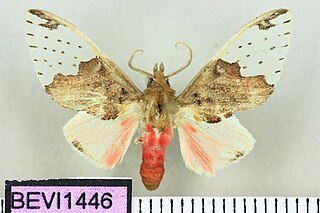Dixophlebia is a genus of moths in the subfamily Arctiinae. The genus was erected by Arthur Gardiner Butler in 1876.
Holophaea is a genus of moths in the subfamily Arctiinae. The genus was erected by George Hampson in 1898.
Metalobosia is a genus of moths in the subfamily Arctiinae. The genus was erected by George Hampson in 1900.

Scaptius is a genus of moths in the family Erebidae erected by Francis Walker in 1855.
Antapistis is a genus of moths of the family Noctuidae.

Oglasa is a genus of moths in the family Erebidae. The genus was first described by Francis Walker in 1859.
Dixophlebia holophaea is a moth of the subfamily Arctiinae. It was described by George Hampson in 1909. It is found in Guyana.
Holophaea caerulea is a moth of the subfamily Arctiinae. It was described by Herbert Druce in 1898. It is found in Ecuador.
Holophaea cardinalis is a moth of the subfamily Arctiinae. It was described by Rothschild in 1911. It is found in Costa Rica.
Holophaea endoleuca is a moth of the subfamily Arctiinae. It was described by Paul Dognin in 1909. It is found in Colombia.
Holophaea eurytorna is a moth of the subfamily Arctiinae. It was described by George Hampson in 1914. It is found in Colombia.
Holophaea gentilicia is a moth of the subfamily Arctiinae. It was described by Schaus in 1911. It is found in Costa Rica.
Holophaea lugens is a moth of the subfamily Arctiinae. It was described by E. Dukinfield Jones in 1908. It is found in Brazil.
Holophaea lycone is a moth of the subfamily Arctiinae. It was described by Herbert Druce in 1884. It is found in Costa Rica and Panama.
Holophaea melita is a moth of the subfamily Arctiinae. It was described by Herbert Druce in 1899. It is found in Ecuador.
Holophaea prometina is a moth of the subfamily Arctiinae. It was described by Herbert Druce in 1894. It is found in Mexico.
Holophaea ruatana is a moth of the subfamily Arctiinae. It was described by Herbert Druce in 1897. It is found in Honduras.
Holophaea vesta is a moth of the subfamily Arctiinae. It was described by Heinrich Benno Möschler in 1877. It is found in Suriname and French Guiana.
Metalobosia holophaea is a moth of the subfamily Arctiinae. It was described by Paul Dognin in 1912. It is found in Colombia.
Scaptius holophaea is a moth in the subfamily Arctiinae. It was described by George Hampson in 1905. It is found in French Guiana, Suriname and Amazonas.

